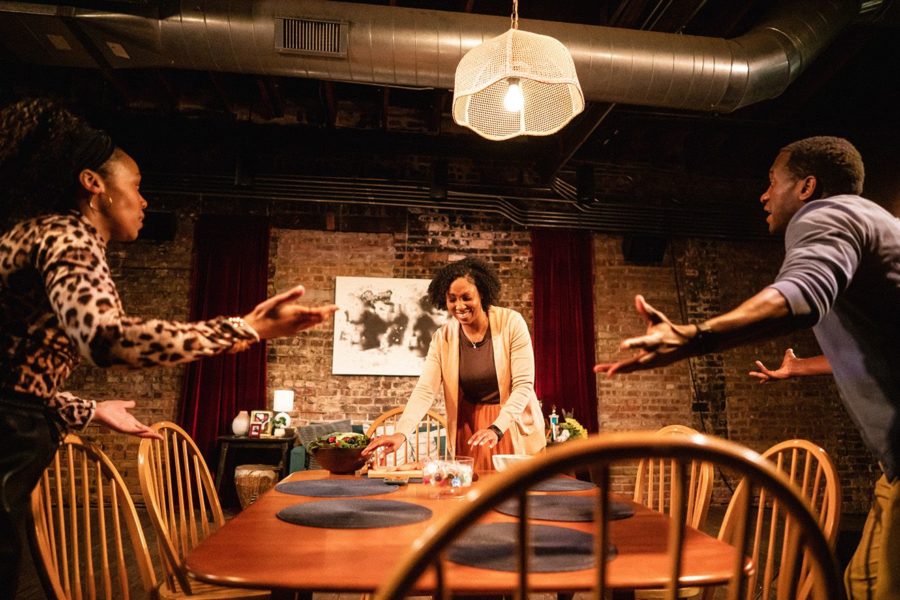At The Revival in Hyde Park, Definition Theatre’s production of Fairview is a cutting, unsettling, and cleverly comedic dissection of race in theater, race in America, and theater in America. Fairview, Jackie Sibblies Drury’s winner of the 2019 Pulitzer Prize for Drama, starts slowly, if not downright blandly. An upper-middle class Black family—married couple Beverly and Dayton Frasier, their daughter Keisha, and Beverly’s sister Jasmine—are preparing for a dinner party to celebrate Beverly and Jasmine’s mother’s birthday. It’s an overworked, uninspired premise populated with caricatures carrying on unrealistic conversations. That is, if you leave during intermission, before the second act. (Perhaps Fairview’s only major weakness is that the first act is so uninteresting as to genuinely threaten departures from those who expect more of the same.)
Post-intermission, however, the tables are (literally and figuratively) flipped. As the Frasiers silently replay their previous interactions, four white characters—Bets, Suze, Jimbo, and Mack—watch this stereotyped Black family. At first, these onlookers’ musings center on what races each would become if they could; later the conversation morphs into a misguided sort of argument about racism. This kind of side-by-side action is hard to write well, harder still to stage well, but Fairview pulls it off quite beautifully. The white characters’ dialogue is never so heavy- handed as to be clearly referring to the actions of the Frasiers yet consistently presents an unsparing contrast between the two sets of characters’ words and worlds.
Eventually, it becomes clear that the Frasier family’s life is either a sick fantasy in the minds of the white characters, or, perhaps more fittingly, a twisted questioning of what it means to watch theater. Jimbo and his friends watch the Frasiers with considerably more hostility than the audience, but the audience shares their fascination and curiosity. What Drury seems to want you to do as you watch the play is not to judge Jimbo, but rather to wonder in what ways you are like Jimbo; this sort of quiet inquisition is generally written and acted quite gracefully, except for a slightly stumbling, overly vague monologue at play’s end.
Juxtaposing the groups of characters is startling in itself, but Fairview does not stop there. One by one, Bets, Jimbo, and Mack enter the world of the Frasiers, casting themselves as elaborate, clichéd versions of Beverly’s mother and brother and Keisha’s girlfriend, respectively. The effect is at once engrossingly comedic and deeply discomfiting, especially because among the Frasiers, Keisha alone notices anything odd about the new members of the family. The first act’s familial relationships, viewed now through the additional lens of race, develop strong, compelling dynamics of power and agency.
It is precisely that devolution, however, that lends the play its strongest moments. This is not a mere callous antagonization of the audience; it is a dissection of the role of art nestled in an adeptly crafted play. Drury acutely understands the form at which she is poking. Director Tyrone Phillips does well to harness Fairview’s chaotic energy, which could otherwise derail the play’s insights: This is a show that makes excellent use of set, costuming, lighting, and especially sound. Sound designer Willow James has crafted a soundscape that is intricate, imaginative, and genuinely shocking.
Much of Fairview is shocking; at its best, the play portrays the appalling and insensitive with grace and humor, and this play is often at its best. Characters throw an impressive quantity of fake spaghetti at each other. Beverly faints. A table crashes. Music plays at unexpected moments, then in a moment shuts off. Flashes of colored light generally accompany that music. And, in the middle of it all, David Goodloe (Dayton) and Kandice Robins (Beverly) anchor Fairview with moving performances in the play’s central marital relationship, a relationship that is, like much in this play, much more intricate than it at first appears.
There are, to this reviewer, two clear moral declarations made by Fairview: the straightforward “don’t judge people based on the color of their skin” and the subtler “let Black actors play Black characters in theater.” The second of these declarations is not as foregone or obvious a conclusion as it might at first seem; thus, Fairview gains its power above mere restatement and didacticism. Where Definition Theatre’s Fairview thrills is in its spectacle—this is theater that critiques theater not for the sake of critique but for the sake of better theater.
Definition Theatre’s production of Jackie Sibblies Drury’s “Fairview” was at The Revival through May 28.









